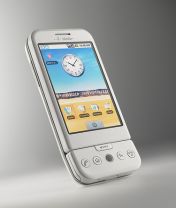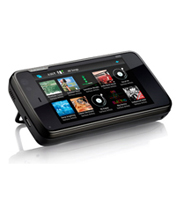Smartphone rundown: five alternatives to getting an iPhone
What are the options for the Apple-averse?

We’ve all been guilty of it. iPhone this, App Store that. Blah blah blah. You’d think that the stylish consumer electronics company from Cupertino had the monopoly on touch-based smartphones.
Contrary to popular belief, it doesn't. Not yet, anyway. Microsoft has had a presence in the smartphone market for years with its Windows Mobile platform, which is belatedly starting to embrace a more intuitive touchscreen interface.
Google, meanwhile, has produced its Android OS, which many people expect will overtake Apple’s device and dominate the market over the coming years.
While the iPhone is a fine device - and undoubtedly the best mobile gaming device at present - it’s not quite out there in a league of its own as some would have you believe. Here are a few of the main alternatives, along with the key features that set them apart from the iPhone.
Android Google’s addition to the smartphone market isn’t a handset. Rather, like Windows Mobile, it’s an operating system. By making Android free to handset manufacturers, Google has made it very easy to jump onboard.
Google’s addition to the smartphone market isn’t a handset. Rather, like Windows Mobile, it’s an operating system. By making Android free to handset manufacturers, Google has made it very easy to jump onboard.
After a slow start with the flawed G1 from HTC, things are beginning to gather pace. It’s been predicted that the total number of Android handsets out or in production is around the 50 mark, which represents a whole new type of problem for Apple to face up to.
Having watched the rather rubbish Matrix Revolutions on telly recently, I would liken iPhone versus Android to Neo versus Agent Smith. There may be only one bad-ass, snazzily attired, ultra powerful Neo (iPhone) but he's swiftly swamped by the sheer expanding mass of Agent Smiths (Android handsets).
If it’s not stretching the analogy a little too far (I can hear it creaking), there’s also a pumped up Smith-Oracle hybrid in the Android line-up that’s ready to take on the iPhone mano a mano.
The Motorola Droid is one impressive-looking piece of kit that looks to have all the functionality of the Android system (which has never been the problem) and the solid design and potent hardware more commonly associated with the iPhone.
What it has that iPhone doesn’tRange - being gregarious, Google’s Android system is cropping up on all manner of devices from the likes of HTC, Samsung, Motorola, Dell and Acer to name just a few. If you don’t happen to like the iPhone hardware, there’s no Apple alternative.
Then there’s the fact that these handsets are available across a number of network operators, so you won’t necessarily have to change network to get onboard with Android.
Google integration - those of us who spend a great deal of time online are living in an increasingly Google-shaped world, with mail, maps, doc sharing and blog aggregation all taken care of by the Californian company.
Having a mobile system that seamlessly taps into all this is a considerable boon, regardless of the fact that Google products continue to work well with other platforms (including iPhone).
Open source - being open source means that the bar for entry for Android app developers is virtually non-existent. If you can code, you can get something onto the Android Marketplace with minimum fuss. With handset sales about to explode, there are going to be a lot of developers turning out a lot of apps for the Google system.
Palm Pre It’s taken a while to get here (it was out in June in the US), but the Palm Pre is a genuine contender for smartphone of the year.
It’s taken a while to get here (it was out in June in the US), but the Palm Pre is a genuine contender for smartphone of the year.
Cute if fairly unremarkable to look at, a large part of its appeal is that it does things slightly different to the others. It’s like that unfashionable football team with the 7ft striker - by taking a slightly different approach it disrupts the established order of things.
The ace up the Pre’s sleeve is webOS, Palm’s custom-made operating system. Placing the focus firmly on the web (hence the name) and connectivity, it cleverly pulls in contact details and other information from a number of separate sources - such as Gmail, Microsoft Outlook and Facebook - and collates it all into a single unified phone book.
The Pre’s physical design is rather less revolutionary, bearing more than a whiff of Apple about it with its curved black lines and minimal physical controls. This is rather unsurprising given that Palm’s executive chairman, Jon Rubinstein, was heavily involved in the creation of the iPod.
What it has that iPhone doesn’tPhysical QWERTY keyboard - a persistent sticking point for those who use their phones to email extensively is the iPhone’s lack of a physical keyboard. The Palm Pre addresses this with a compact slide-out solution.
A camera with a flash - it might ‘only’ be a simple 3.2 megapixel job, but the addition of an LED flash makes the Pre a superior choice to the iPhone for those who like to take snaps in poorly lit environments. With winter fast approaching, that’ll soon be pretty much any time and place in the UK.
webOS - the Pre’s ability to collate all of your contact details really is the best example to date of cloud computing on a mobile system. Expect it to be widely imitated in 2010.
Windows Mobile Like Android, Windows Mobile is an OS running across multiple handsets, so it’s a rather different proposition to the iPhone. Unlike Android, however, it appears to have fallen behind the smartphone curve in terms of usability and stability.
Like Android, Windows Mobile is an OS running across multiple handsets, so it’s a rather different proposition to the iPhone. Unlike Android, however, it appears to have fallen behind the smartphone curve in terms of usability and stability.
The latest version of Windows Mobile - 6.5 - is the unwanted child of the WinMo family. Microsoft CEO Steve Ballmer appears to have disowned the update already, claiming that it’s, "not the full release [Microsoft] wanted."
The release it’s standing in for is the much-delayed Windows Mobile 7, which promises to be a total overhaul of the aging WinMo 6 OS. It promises to make full use of the now obligatory touchscreen interface with elements such as multi-touch and gestural commands.
Regardless of the controversy surrounding the current iteration, though, a Windows Mobile phone is the only way to go for a considerable number of people. Needless to say its interaction with the widely used Microsoft Office is unmatched on any other platform, which makes it a vital tool for many people conducting their day to day business.
Windows Mobile continues to be the only option for many business-orientated users, and with units like the Sony Ericsson Xperia X2 in the pipeline it shouldn't be discounted by casual users either.
What it has that iPhone doesn’tMulti tasking - this is the biggest stick for beating the iPhone with by any Windows Mobile user. The ability to run multiple applications simultaneously is seen as crucial by many, and it’s something that the iPhone fails to do.
Flash support - iPhone’s slick Safari browser still doesn’t support Adobe’s widely used multimedia platform, leaving web browsing on the Apple unit a frustratingly incomplete experience. Microsoft Windows does, which is a distinct advantage.
BlackBerry Storm If there’s one brand that stands between the iPhone and a firm foothold in the business sector it’s BlackBerry. Research In Motion’s pioneering line of portable email devices - among the first smartphones - has come to dominate among the busy city workers of the western world.
If there’s one brand that stands between the iPhone and a firm foothold in the business sector it’s BlackBerry. Research In Motion’s pioneering line of portable email devices - among the first smartphones - has come to dominate among the busy city workers of the western world.
The BlackBerry Storm is RIM’s first attempt at a broader market, and as such it’s the first to feature a touchscreen rather than a physical QWERTY keyboard.
This is no me-too iDevice, though, and RIM continues its reputation for innovation by implementing its own SurePress technology, which turns the entire screen into clickable button.
However, this fresh approach appears to be something of an acquired taste, as many reviewers have criticised the system when it comes to typing out texts and emails (a cardinal sin for any BlackBerry device). There’s also the matter of no wi-fi support.
The imminent BlackBerry Storm 2 promises to rectify these issues, making the line one to watch at the very least.
What it has that iPhone doesn’tSurePress technology - this feature addresses an issue that many people have with touch-only devices such as the iPhone - the lack of haptic feedback. What this equates to is a full capacitive touchscreen that can be physically ‘clicked’ like a mouse button in order to select items.
A camera with a flash - like the Palm Pre, the BlackBerry Storm features a 3.2 megapixel camera with a flash. The iPhone’s snapper is only good for well lit areas.
Expandable memory - the Storm has a handy MicroSD slot that allows for up to 32GB of memory expansion, the lack of which is commonly criticised in the iPhone.
Nokia N900 Nokia has had a few attempts at the touchscreen smartphone format now, with mixed results. While the handset giant itself has been pushing the N97 as its flagship device, however, it's the imminent N900 that boasts all the right ingredients to take on the iPhone.
Nokia has had a few attempts at the touchscreen smartphone format now, with mixed results. While the handset giant itself has been pushing the N97 as its flagship device, however, it's the imminent N900 that boasts all the right ingredients to take on the iPhone.
Positioned by Nokia, perhaps ill-advisedly, as a mobile internet tablet, it is in fact an incredibly powerful and flexible smartphone. Abandoning the S60 OS, this is the first Nokia phone to run on its Linux-based Maemo OS.
What that means is a much-improved (compared to previous Nokia efforts) user interface that allows a great deal of customisation, pinning widgets to your Home screen rather than simple icons. There’s also an ultra-zippy web browser included, which is helped no end by the powerful processor and graphics acceleration under the phone’s bonnet.
It remains to be seen whether the N900 will be a successful competitor in the touchscreen smartphone market, but there’s little doubt it’s Nokia’s finest attempt yet. Just look at the list of features below - it does a lot of the things that the other handsets on this list do and that the iPhone doesn’t.
What it has that iPhone doesn'tFlash support - like Windows Mobile, Nokia’s N900 supports the Adobe multimedia platform. It’s all part of a remarkably fluid web browsing experience on the device.
Multitasking - also like WinMo, the N900 allows you to run multiple programs simultaneously.
Take pictures in the dark - another device that allows you to take pictures in the dark, this time with a dual LED flash and a 5MP camera.
Expandable memory - up to 16GB of extra microSDHC storage.
Physical QWERT keyboard - like the Pre and a number of Android and WinMo units, the N900 has opted for a physical keyboard, which is a major consideration if you're big on emailing on the go.
